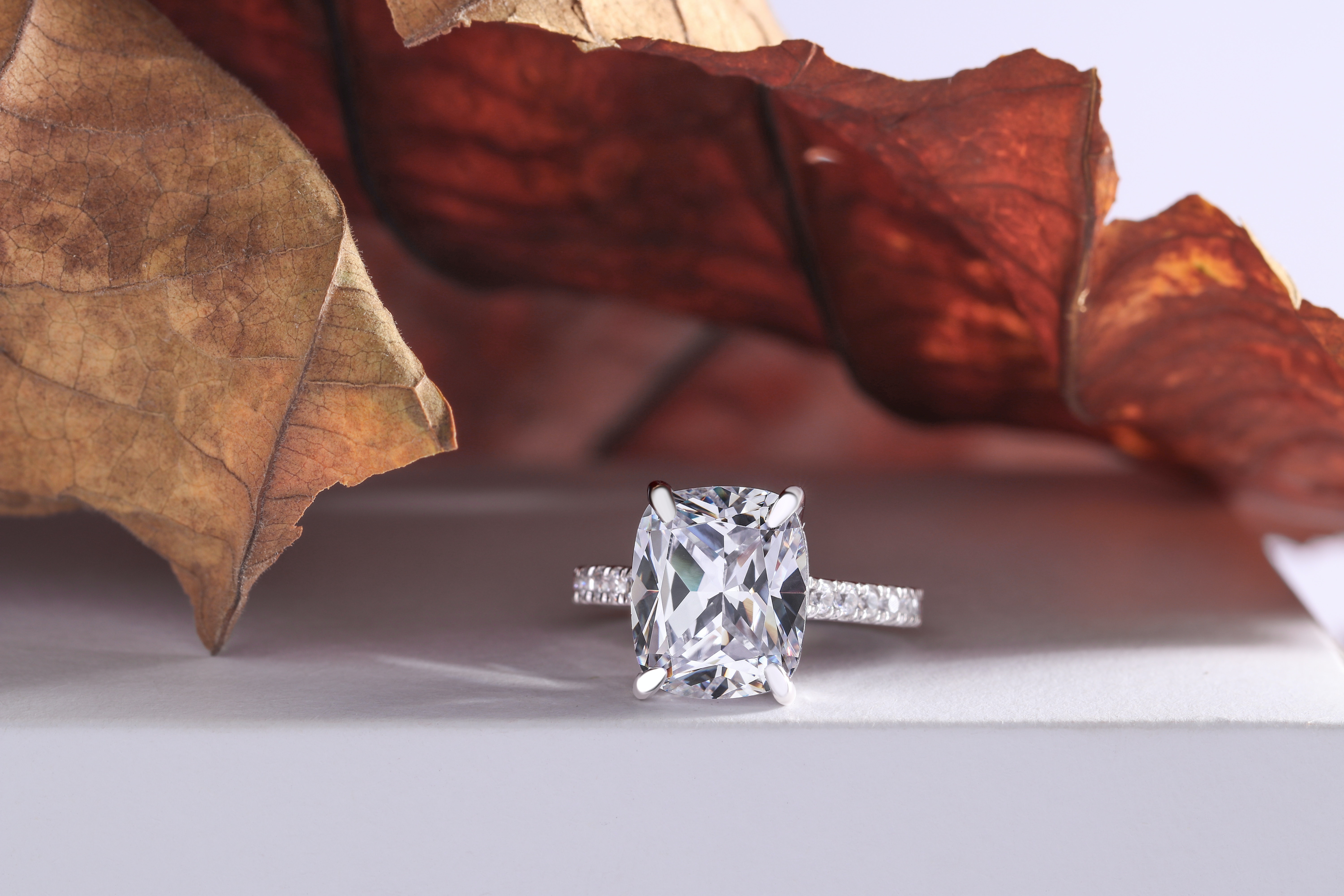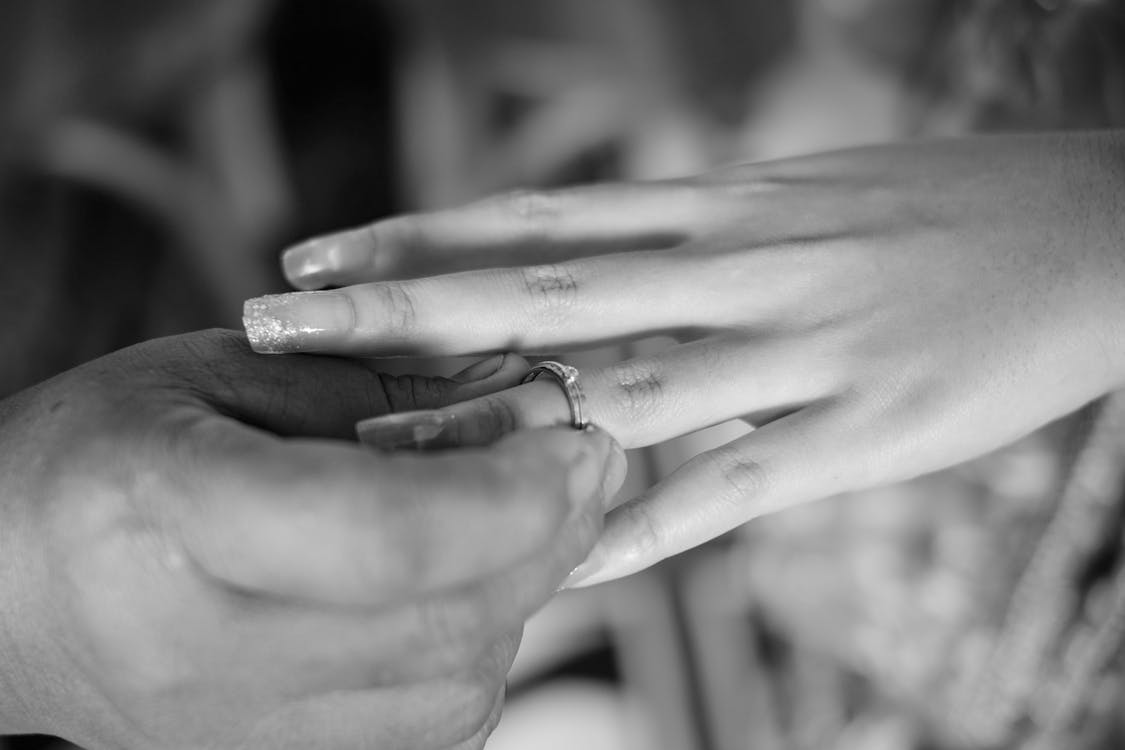- Call us: (213) 489-1767

When planning a marriage proposal, there are so many different things to consider. You need to pick the place, you need to pick the perfect time, and of course, you need to make sure that you pick the perfect diamond engagement ring!
There’s plenty to consider when trying to find the ideal engagement ring but one of the most common questions is how big should the diamond be.
There is no right or wrong answer. It is all a matter of choice but the diamond size will relate to the diamond shape, type of ring, the ring setting, and of course the price tag.
When looking for a diamond engagement ring, buy from a high-quality jeweler. They will have staff who will be happy to guide you through the process of buying diamonds and help you decide the right size of the diamond for your perfect ring.
Choosing Diamonds

The sale of diamonds is very closely controlled to ensure that a buyer knows exactly what they are paying for.
Diamonds are certified by the Gemological Institute of America (GIA) so whatever decisions you make regarding diamond shape and diamond size, do not buy any stone that does not have a certificate of its authenticity.
The GIA (and other bodies) grade diamonds on four features: cut, carat, color, and clarity. Together they are known as the 4Cs. The GIA diamond report will detail all of these quite succinctly and your jeweler will happily explain what they mean.
For this article, we are going to concentrate on size, i.e. carat but we’ll also explain the relation to the other Cs as appropriate.
What Is Carat Size?
The size of a diamond is described by its carat weight.
Carat is the name for the unit of measurement for the weight of a cut diamond. A one-carat diamond is equal to one-fifth of a gram or 200 milligrams.
A diamond’s carat size is generally synonymous with its overall size, but there can be other factors like shape/cut that have an impact on how it looks to the naked eye.
A 1-carat diamond is usually more than enough to satisfy the needs of an engagement ring with a center diamond solitaire that shouts bling! Even a half-carat diamond is enough to pack a huge punch of sparkle and this is the current national average engagement ring diamond size.
When you start talking about 1.5-carat and 2-carat diamonds, you’re in the realm of true luxury. You might see the rich and famous sporting up to 4 carats and beyond, but that isn’t generally practical or achievable for most budgets and lifestyles!
Consider Your Budget First And Foremost
No matter how much your love your partner or how ambitious you are, your budget will be a major consideration.
Diamonds are beautiful items to possess and of course, you want to present the best ring you can, but they are not worth getting yourself into financial trouble and over-stretching your bank account to get a big diamond for a world-beating selfie on social media.
The best thing to do is tell your jeweler right from the start what your maximum budget is and they will make it part of their job to seek out the best options for you within those specific parameters.
Remember that carat weight isn’t the only C factor that can affect a diamond’s price and quality. You have cut, color, and clarity to think about too, and a 0.5-carat perfect diamond is going to sparkle and shine more than a large diamond of two carats that has lots of visible inclusions.
Don’t focus all of your attention on the size of a diamond. Instead, try to look at it from all angles to come up with the one that best suits your overall needs.
Consider The Size And Shape Of Her Hands/Fingers

Alongside budget, you should also consider your partner and what they might prefer.
How will the diamond look on her hand and fingers? Does she have slim digits that would suit a smaller diamond or wider fingers that needs something like a big-carat marquise to have the best impact? No two sets of hands are ever the same, so it is important to base your choices on the person you are buying for.
For particularly dainty hands, you can get away with going as low as 0.2 or 0.3 carats, whereas larger, wider hands will always look better with the 0.8 to 1.5-carat range. The aim is to cover as much surface area on the finger as possible without busting your budget or making the ring look too over the top for everyday wear.
Consider Shape in Relation to Carat Weight
Shape is important. A diamond expert will have taken the rough stone and decided which cut will make the most of the natural fire and scintillation. While round brilliant cut diamonds are by far the most common choice, especially for a solitaire engagement ring, looking at different diamond shapes can help you find a ring that might better fit your intended’s personality and style.

Look at different engagement ring styles. Round diamonds work wonderfully well in solitaire engagement rings but so do emerald cut and princess cut. You might also consider an arrangement of stones rather than just a single round-cut center stone. Round diamonds and baguette or emerald cuts work very well in three-stone rings or combinations with side stones. There’s also the option of mixing diamonds with other gemstones such as sapphires.
The point is to not have a preconceived idea that an engagement ring has to be a classic solitaire diamond on a band of gold. Your jeweler will be able to show you a wonderful range of rings in all different styles, all different diamond shapes, all different settings, and all different carat and combined carat weights.
Think In Terms Of Practicality
Think about the kind of lifestyle that your partner has, for example, are they particularly active? Are they involved in any kind of manual labor? Do they play a lot of sports? If the answer to any of those questions is yes, then a huge-carat diamond might not be the appropriate choice for them.
If you truly know your loved one and have an understanding of what they are going to need in an engagement ring, then the statistics around average diamond size don’t tend to matter all that much.
Diamonds are the hardest naturally occurring substance on the planet, so even the most active fiancé isn’t going to easily damage her ring. It is more of a decision about the actual size of the stone to avoid her becoming annoyed with it on her finger. You want to limit the risk of things like knocking and catching.
Get More For Less
If your partner is dreaming of a large engagement ring size that packs a punch but your budget can’t handle it, there are plenty of different and clever ways to get around the money/size issue.
Perfect diamonds are very rare and you will pay a premium for any stone that is near the top of any of the 4 C grading scales but stones with lower grades are beautiful too.
Stones that are graded at a lower point on the clarity front (like salt and pepper diamonds) have a unique character all of their own that a lot of people prefer. Others that have a slightly yellow tinge can be bought for much less, and they don’t always look like they are poor quality just because they possess a shading of color.
Again, talk to the jeweler for a frank assessment. They will guide you on what can be played off against each other to achieve the best quality stone for your money. You might, for example, sacrifice carat weight to achieve better clarity or color.
Design can also help you make the most of less expensive stones. To get maximum sparkle out of your carat weight, a halo setting is always a good idea to boost the diamond’s profile. Encircling the diamond in several smaller diamonds can also have a massive impact, allowing you to opt for a smaller central stone and lowering the overall price tag.
And remember too, there is always the option of lab-grown diamonds which are cheaper but still as beautiful.
Shop Stein Diamonds Wedding Rings

